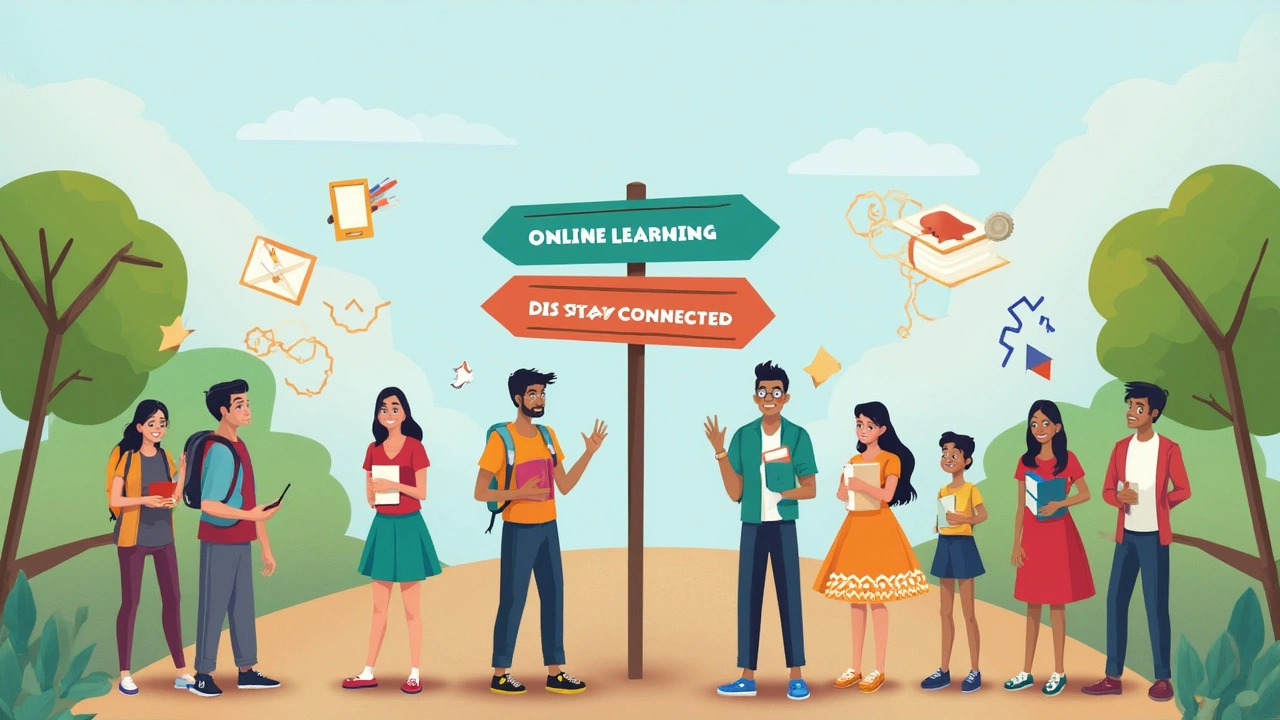If you’re confused about the difference between distance learning and online learning, you’re not alone. A lot of people use the terms like they mean the same thing…but they don’t. Understanding how they actually work can make a big difference in how you study and succeed.
Think about it this way: distance learning is the big umbrella. It means learning when you’re not sitting in a traditional classroom. This could be by mail, on your computer, even over the radio (yep—some places still do!). Online learning is a piece of that umbrella. It only happens on the internet—no mailing, no printed packets, everything digital. So, every online learner is a distance learner, but not all distance learners are online learners. See where this is going?
Most universities and schools have ramped up their online options since 2020, but distance learning has been around for over a century. In fact, one of the first recorded distance courses happened in the 1840s, when a guy in Britain mailed lessons and received homework by post. The tech has changed a lot, but the main idea—learning from afar—hasn’t.
- Breaking Down the Basics
- Technology: The Deciding Factor
- How Courses Are Delivered
- Student Experience and Interaction
- How to Pick What Works for You
Breaking Down the Basics
Let’s start with what these terms really mean. Distance learning is the bigger concept. It covers any kind of education where the student isn’t physically in a classroom with the teacher. This could be through video calls, printed materials sent by mail, or even broadcasts over TV and radio. It’s all about learning from somewhere else, with the support of a school or training provider.
Online learning, on the other hand, is a type of distance learning. Here, everything happens on the internet. Your lessons, assignments, discussions, and feedback all go through digital platforms. Think of Zoom lectures, learning portals, online quizzes, email feedback from teachers—if it needs the web, it counts as online.
Check out this quick table to see how they stack up:
| Feature | Distance Learning | Online Learning |
|---|---|---|
| Requires Internet | Not always | Always |
| Material Delivery | Mail, TV, Radio, Online | Website/Apps only |
| Interaction with Teachers | Mail, Phone, Sometimes Online | Mostly Online |
| Common Since | 1800s | Mid-1990s |
The main thing: all distance learning keeps you away from the campus, but not all of it is online. If you have slow internet or better focus reading printed notes, you might find classic distance courses a better fit. But if you want instant answers, group video calls, or digital tools, online learning opens a different set of options.
Technology: The Deciding Factor
When it comes to distance learning versus online learning, technology is what splits them apart. The tools you use—and need—are pretty different. If you’re considering either route, you’ve got to look at what gadgets, internet speed, and software you’ll have to work with every day.
Traditional distance learning can be completely off the grid. Courses could arrive by mail, radio, or even on a USB stick. You don’t need fancy computers or lightning-fast Wi-Fi. This is still a thing in some rural areas or places with spotty internet. You might just need a basic phone for support calls or chats with an advisor.
Online learning goes all-in on the internet. Here, everything’s digital—videos, apps, digital textbooks, interactive quizzes, forums, and Zoom sessions. Without a stable connection and at least a decent laptop or tablet, you’re going to struggle.
Here’s a quick look at the tech requirements for both options:
| Learning Type | Main Delivery Method | Tech Needed |
|---|---|---|
| Traditional Distance Learning | Mail, radio, phone | Mail access, phone (sometimes) |
| Online Learning | Internet-based | Reliable internet, computer/tablet, webcam, microphone |
In 2023, a study in the US showed that 95% of online learners accessed courses from a laptop or desktop, while only about 3% used just a mobile phone. This says a lot about what you’ll need if you go the online route. If your internet connection is shaky, online learning might get really frustrating.
Pro tip: Before enrolling, check if your school offers tech support or device loans. And if you’re aiming for fully online classes, run an internet speed check. Most platforms recommend at least 10 Mbps download speed for video calls without lag.

How Courses Are Delivered
The way lessons and assignments get to you is one of the biggest ways distance learning and online learning stand apart. People sometimes imagine it’s all Zoom and emails, but there’s a wider world out there, especially in distance learning.
- Distance learning: Delivery can be old school or digital. You might get printed packets, textbooks, and DVDs mailed to you. Some courses still use radio or TV broadcasts for lessons. Think of places with spotty internet or learners with limited tech—these folks rely on physical materials.
- Online learning: Everything happens through the internet. Lectures are streamed (live or recorded), assignments are uploaded to platforms like Canvas or Moodle, and feedback comes in through email or chat. Many online courses run on learning management systems (LMS) that keep track of lessons, quizzes, forums, and grades in one place.
In a study published by EduCause Review in 2023, 89% of U.S. universities were using some form of LMS to deliver online classes. That means nearly everyone studying online interacts with systems like Blackboard, Google Classroom, or Canvas nearly every day.
There are pros and cons to each method. Getting stuff in the mail might sound slow, but it works for people who don’t have fast internet. Online delivery is instant and interactive, but it does assume you have reliable access and the right devices.
"The move to online delivery doesn’t just change the tech—it changes how students and teachers connect, how feedback happens, and even when learning takes place." – Dr. Paula Grabowski, Digital Education Research Group
If you’re all about schedules, here’s a quick look at the typical turnaround times for materials and assignments in both setups:
| Method | Receiving Lessons | Submitting Assignments | Getting Feedback |
|---|---|---|---|
| Distance (mail) | 3-14 days (postal delivery) | By mail or scanned email upload | Up to 2 weeks (depends on mail and grading) |
| Online | Instant download/access | Via upload to LMS or email | 1-3 days (often much faster) |
One handy tip: If you’re thinking about jumping into distance learning because your internet is unreliable, ask how much of the material is offered offline. Some programs mix both methods, letting you download lessons and upload homework when you’re back online.
Student Experience and Interaction
Here’s where things get real for students. The experience in distance learning can feel a lot different compared to online learning, and depending on what you need, that difference matters.
With old-school distance learning—think mailed courses or printed packets—you’re often working alone. Communication with instructors is slow, usually by email or regular mail, so feedback takes time. Group projects? Rarely happen. You might never see or even speak to your classmates. Some people love the independence, but others feel completely isolated.
Jump over to online learning and the vibe is more connected. Platforms like Zoom, Microsoft Teams, and Moodle make it way easier to interact. Got a question? Many online platforms let you message your teacher or classmates right away. There are live video classes, discussion boards, online group projects, and sometimes even breakout rooms for small group chats. Interaction can happen at any time, not just during a set class period.
Here are a few ways student interaction changes between these two:
- Distance learning: Mostly self-paced work, limited direct contact, and slow back-and-forth with instructors.
- Online learning: Real-time classes, instant messaging, digital group projects, and quick feedback loops.
It’s worth noting that not everyone prefers constant interaction. Some students thrive working solo with fewer distractions. Still, research from places like the Open University in the UK shows students in interactive distance learning settings are more likely to finish their courses and feel less isolated. If hanging out virtually with classmates sounds motivating, online learning could be your thing. If you value flexibility and working solo, traditional distance learning might be better.
Tip: Before enrolling, look for course info about interaction—some programs mix both styles, so you can get the best of both worlds.

How to Pick What Works for You
Not every learning style fits everyone. So, how do you know whether distance learning or online learning will work best for you? It really boils down to your habits, access to tech, the program you want, and even where you live.
Ask yourself a few key questions:
- Do you have a reliable internet connection? If not, traditional distance learning with mailed materials might give you less hassle.
- Are you comfortable using apps like Zoom, Google Classroom, or Microsoft Teams? If you enjoy working online, online courses will probably suit you better.
- Do you need face-to-face spots, lab time, or work placements? Some things are just easier in person no matter the tech.
- Do you have a strict schedule, or do you need flexibility? Online courses often have live video sessions, but many distance learning programs are more flexible about when you log in or send work back.
Check the facts: According to a 2023 study by EduData, 79% of online learners said the flexibility helped them finish their courses faster, while only 51% of distance (mail-based) learners reported the same. But on the flip side, 68% of non-online distance learners said fewer tech issues disrupted their studies compared to just 31% of online students.
| Type | Flexibility Reported | Tech Problems |
|---|---|---|
| Online Learning | 79% | 31% |
| Distance (Mail-Based) | 51% | 68% |
Before signing up, talk directly with the course provider. Ask what kind of support they offer, like video tutorials, troubleshooting, or personal feedback. Some places even let you try sample lessons to see how it feels before you commit.
Tip: Double-check exam and assignment rules. Some programs need you to show up in person for major tests, even if you study by mail or online. If you live far from any test center, that could be a dealbreaker.
Don’t ignore your gut feeling. If you loathe tech glitches and prefer real books and papers, distance learning fits. If you love interactive group work, videos, and don’t mind the odd tech hiccup, online learning might be your thing. Picking the right style makes a bigger difference than most folks think.
